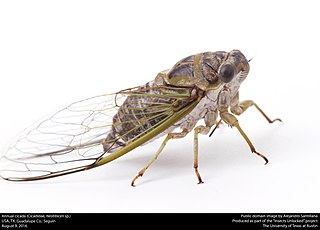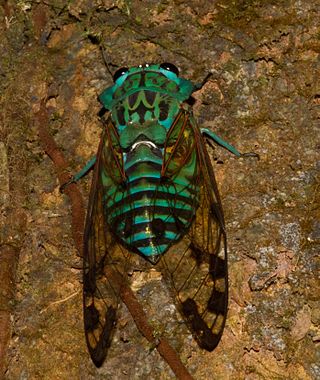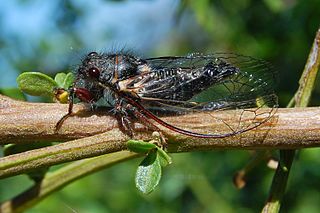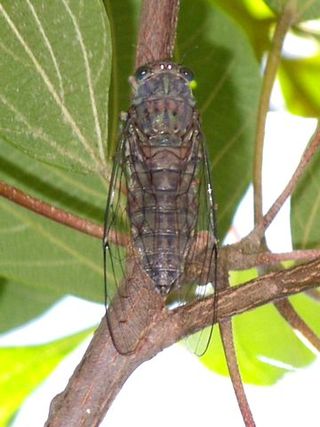Related Research Articles

Cicadidae, the true cicadas, is one of two families of cicadas, containing almost all living cicada species with more than 3,200 species worldwide.

Pomponia is a genus of cicadas from Asia. A group of species previously placed in Pomponia, containing the largest cicada species found on earth, have recently been moved to Megapomponia. However, the remaining species still form a very heterogeneous group and Duffels and Hayashi (2006) mentioned that several species should probably be transferred to genera like Terpnosia and Leptosemia.

The Cicadinae are a subfamily of cicadas, containing the translucent cicadas. They are robust cicadas and many have gaudy colors, but they generally lack the butterfly-like opaque wing markings found in many species of the related Tibiceninae.

Gaeanini is a tribe of cicadas in the family Cicadidae, found in the Palearctic and Indomalaya. There are about 10 genera and at least 50 described species in Gaeanini.

Tosenini is a tribe of cicadas in the family Cicadidae. There are at least 10 described species in Tosenini, found in the Palearctic and Indomalaya.

Platypleura is a genus of cicadas that occurs widely across Africa and southern Asia. Some of the South African species are remarkable for their endothermic thermoregulation that enables crepuscular signalling, an adaptation that reduces risk of predation and enables a greater range for their calls. In field experiments their maximum body temperature while calling at dusk, was measured at 22 °C above ambient temperature.

Cryptotympanini is a tribe of cicadas in the family Cicadidae. They are found in the Nearctic, Palearctic, Indomalaya, Oceania, and Afrotropics.

The Fidicinini are a tribe of cicadas. There are at least 20 genera and 250 described species in Fidicinini, found in the Nearctic and Palearctic.

The Zammarini is a tribe of cicadas. They are native to the Americas, especially the Neotropics.

The Platypleurini are a tribe of cicadas from the Afrotropical and Oriental regions There are at least 30 genera and 240 described species in Platypleurini.

The Dundubiini are a tribe of cicadas in the family Cicadidae, found in the Palearctic, Indomalaya, Australasia, and the Western Pacific. There are at least 180 described species in Dundubiini.

Carinetini is a tribe of cicadas in the family Cicadidae, found in the neotropics. There are about 7 genera and at least 90 described species in Carinetini.

Tettigomyiinae is a subfamily of cicadas in the family Cicadidae, found in tropical Africa. There are about 16 genera and at least 100 described species in Tettigomyiinae.

Tibicininae is a subfamily of cicadas in the family Cicadidae. There are 5 tribes and at least 140 described species in Tibicininae. They are found in the Neotropics, the Nearctic, and the Palearctic.

Leptopsaltriini is a tribe of cicadas in the family Cicadidae. There are at least 200 described species in Leptopsaltriini, found in the Palearctic, Nearctic, and Indomalaya.
Tettigomyiini is a tribe of cicadas in the family Cicadidae, found in Africa and Madagascar. There are about 8 genera and at least 60 described species in Tettigomyiini.

Dundubia is a genus of cicadas in the subfamily Cicadinae and the type genus of the tribe Dundubiini.
References
- 1 2 "Cicadinae Report". Integrated Taxonomic Information System. Retrieved 2018-07-03.
- 1 2 "Cicadinae Subfamily Information". BugGuide.net. Retrieved 2018-07-03.
- ↑ Marshall, David C.; Moulds, Max; Hill, Kathy B. R.; Price, Benjamin W.; et al. (2018). "A molecular phylogeny of the cicadas (Hemiptera: Cicadidae) with a review of tribe and subfamily classification". Zootaxa. 4424 (1). Magnolia Press: 1–64. doi:10.11646/zootaxa.4424.1.1. PMID 30313477.
- ↑ Genus Tibicen
- 1 2 Moulds, M.S. (2018). "Cicada fossils (Cicadoidea: Tettigarctidae and Cicadidae) with a review of the named fossilised Cicadidae". Zootaxa. 4438 (3). Magnolia Press: 443–470. doi: 10.11646/zootaxa.4438.3.2 . PMID 30313130.
- ↑ "Catalogue of Life" . Retrieved 2018-07-03.
- ↑ "GBIF" . Retrieved 2018-07-03.